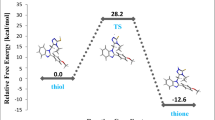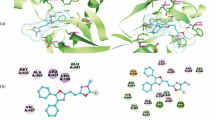Abstract
4-(Phenylamino)-pyrrolo[2,1-f][1,2,4]triazines have been discovered as inhibitors of p38α. Experimental assays have proven that the configuration of α-Me-benzyl connected with amide at C6 is essential for the binding affinity. The S-configured inhibitor (11j) displays 80 times more potency than the R-configured one (11k). Here we investigated the mechanism how different configurations influence the binding affinity using molecular dynamics simulations, free energy calculations and free energy decomposition analysis. We found that the van der Waals interactions play the most important role in differentiating the activities between 11j and 11k with p38α. The difference of the van der Waals interactions is primarily determined by two residues, LEU108 and LEU167. Consequently stabilization of pyrrolo[2,1-f][1,2,4]triazine ring is important for the activities of inhibitors. Meanwhile we observed that the different configuration of the α-Me-benzyl group leads to the difference of binding between 11j and 11k. In conclusion, our work shows that it is feasible to analyze the chirality effect of inhibitors with different configurations by molecular dynamics simulations and free energy calculations, and provides useful information for drug design.











Similar content being viewed by others
References
English JM, Cobb MH (2002) Pharmacological inhibitors of MAPK pathways. Trends Pharmacol Sci 23:40–45
Salituro FG, Germann UA, Wilson KP, Bemis GW, Fox T, Su MSS (1999) Inhibitors of p38 MAP kinase: therapeutic intervention in cytokine-mediated diseases. Curr Med Chem 6:807–823
Foster ML, Halley F, Souness JE (2000) Potential of p38 inhibitors in the treatment of rheumatoid arthritis. Drug News & Perspect 13:488–497
Kumar S, Boehm J, Lee JC (2003) p38 map kinases: key signalling molecules as therapeutic targets for inflammatory diseases. Nat Rev Drug Discov 2:717–726
Saklatvala J (2004) The p38 MAP kinase pathway as a therapeutic target in inflammatory disease. Curr Opin Pharmacol 4:372–377
Choy EHS, Panayi GS (2001) Mechanisms of disease: cytokine pathways and joint inflammation in rheumatoid arthritis. N Engl J Med 344:907–916
Han J, Lee JD, Bibbs L, Ulevitch RJ (1994) A map kinase targeted by endotoxin and hyperosmolarity in mammalian-cells. Science 265:808–811
Han JH, Lee JD, Tobias PS, Ulevitch RJ (1993) Endotoxin induces rapid protein-tyrosine phosphorylation in 70z/3 cells expressing Cd14. J Biol Chem 268:25009–25014
Jiang Y, Chen CH, Li ZJ, Guo W, Gegner JA, Lin SC, Han JH (1996) Characterization of the structure and function of a new mitogen-activated protein kinase (p38 beta). J Biol Chem 271:17920–17926
Lechner C, Zahalka MA, Giot JF, Moller NPH, Ullrich A (1996) ERK6, a mitogen-activated protein kinase involved in C2C12 myoblast differentiation. Proc Natl Acad Sci USA 93:4355–4359
Li ZJ, Jiang Y, Ulevitch RJ, Han JH (1996) The primary structure of p38 gamma: a new member of p38 group of MAP kinases. Biochem Biophys Res Commun 228:334–340
Cuenda A, Dorow DS (1998) Differential activation of stress-activated protein kinase kinases SKK4/MKK7 and SKK1/MKK4 by the mixed-lineage kinase-2 and mitogen-activated protein kinase kinase (MKK) kinase-1. Biochem J 333:11–15
Kumar S, McDonnell PC, Gum RJ, Hand AT, Lee JC, Young PR (1997) Novel homologues of CSBP/p38 MAP kinase: activation, substrate specificity and sensitivity to inhibition by pyridinyl imidazoles. Biochem Biophys Res Commun 235:533–538
Jiang Y, Gram H, Zhao M, New LG, Gu J, Feng LL, DiPadova F, Ulevitch RJ, Han JH (1997) Characterization of the structure and function of the fourth member of p38 group mitogen-activated protein kinases, p38 delta. J Biol Chem 272:30122–30128
Fearns C, Kline L, Gram H, Di Padova F, Zurini M, Han J, Ulevitch RJ (2000) Coordinate activation of endogenous p38 alpha, beta, gamma, and delta by inflammatory stimuli. J Leukoc Biol 67:705–711
Allen M, Svensson L, Roach M, Hambor J, McNeish J, Gabel CA (2000) Deficiency of the stress kinase p38 alpha results in embryonic lethality: characterization of the kinase dependence of stress responses of enzyme-deficient embryonic stem cells. J Exp Med 191:859–869
Hale KK, Trollinger D, Rihanek M, Manthey CL (1999) Differential expression and activation of p38 mitogen-activated protein kinase alpha, beta, gamma, and delta in inflammatory cell lineages. J Immunol 162:4246–4252
Cirillo PF, Pargellis C, Regan JT (2002) The non-diaryl heterocycle classes of p38 MAP kinase inhibitors. Curr Top Med Chem 2:1021–1035
Kumar S, Blake SM (2005) Pharmacological potential of p38 MAPK inhibitors. In: Inhibitors of protein kinases and protein phosphates, vol 167. pp 65–83
Adams JL, Badger AM, Kumar S, Lee JC (2001) p38 MAP kinase: molecular target for the inhibition of pro-inflammatory cytokines. Prog Med Chem 38:1–60
Jackson PF, Bullington JL (2002) Pyridinylimidazole based p38 MAP kinase inhibitors. Curr Top Med Chem 2:1011–1020
Lee JC, Kumar S, Griswold DE, Underwood DC, Votta BJ, Adams JL (2000) Inhibition of p38 MAP kinase as a therapeutic strategy. Immunopharmacology 47:185–201
Leftheris K, Ahmed G, Chan R, Dyckman AJ, Hussain Z, Ho K, Hynes J, Letourneau J, Li W, Lin SQ et al (2004) The discovery of orally active triaminotriazine aniline amides as inhibitors of p38 MAP kinase. J Med Chem 47:6283–6291
Gill AL, Frederickson M, Cleasby A, Woodhead SJ, Carr MG, Woodhead AJ, Walker MT, Congreve MS, Devine LA, Tisi D (2005) Identification of novel p38 alpha MAP kinase inhibitors using fragment-based lead generation. J Med Chem 48:414–426
Goldberg DR, Hao MH, Qian KC, Swinamer AD, Gao DHA, Xiong Z, Sarko C, Berry A, Lord J, Magolda RL (2007) Discovery and optimization of p38 inhibitors via computer-assisted drug design. J Med Chem 50:4016–4026
Hynes J, Dyckman AJ, Lin SQ, Wrobleski ST, Wu H, Gillooly KM, Kanner SB, Lonial H, Loo D, McIntyre KW (2008) Design, synthesis, and anti-inflammatory properties of orally active 4-(phenylamino)-pyrrolo[2, 1-f][1, 2, 4]triazine p38 alpha mitogen-activated protein kinase inhibitors. J Med Chem 51:4–16
Huo SH, Wang JM, Cieplak P, Kollman PA, Kuntz ID (2002) Molecular dynamics and free energy analyses of cathepsin D-inhibitor interactions: insight into structure-based ligand design. J Med Chem 45:1412–1419
Kuhn B, Kollman PA (2000) Binding of a diverse set of ligands to avidin and streptavidin: an accurate quantitative prediction of their relative affinities by a combination of molecular mechanics and continuum solvent models. J Med Chem 43:3786–3791
Weis A, Katebzadeh K, Soderhjelm P, Nilsson I, Ryde U (2006) Ligand affinities predicted with the MM/PBSA method: dependence on the simulation method and the force field. J Med Chem 49:6596–6606
Wang JM, Morin P, Wang W, Kollman PA (2001) Use of MM-PBSA in reproducing the binding free energies to HIV-1 RT of TIBO derivatives and predicting the binding mode to HIV-1 RT of efavirenz by docking and MM-PBSA. J Am Chem Soc 123:5221–5230
Hou TJ, Chen K, McLaughlin WA, Lu BZ, Wang W (2006) Computational analysis and prediction of the binding motif and protein interacting partners of the Abl SH3 domain. Plos Comput Biol 2:46–55
Hou TJ, Guo SL, Xu XJ (2002) Predictions of binding of a diverse set of ligands to gelatinase-A by a combination of molecular dynamics and continuum solvent models. J Phys Chem B 106:5527–5535
Hou TJ, Yu R (2007) Molecular dynamics and free energy studies on the wild-type and double mutant HIV-1 protease complexed with amprenavir and two amprenavir-related inhibitors: mechanism for binding and drug resistance. J Med Chem 50:1177–1188
Wang JM, Hou TJ, Xu XJ (2006) Recent advances in free energy calculations with a combination of molecular mechanics and continuum models. Curr Comput-Aided Drug Des 2:287–306
Kollman PA, Massova I, Reyes C, Kuhn B, Huo SH, Chong L, Lee M, Lee T, Duan Y, Wang W (2000) Calculating structures and free energies of complex molecules: combining molecular mechanics and continuum models. Acc Chem Res 33:889–897
Hou TJ, McLaughlin W, Lu B, Chen K, Wang W (2006) Prediction of binding affinities between the human amphiphysin-1 SH3 domain and its peptide ligands using homology modeling, molecular dynamics and molecular field analysis. J Proteome Res 5:32–43
Hou TJ, Zhang W, Case DA, Wang W (2008) Characterization of domain-peptide interaction interface: a case study on the amphiphysin-1 SH3 domain. J Mol Biol 376:1201–1214
Gohlke H, Case DA (2004) Converging free energy estimates: MM-PB(GB)SA studies on the protein–protein complex Ras-Raf. J Comput Chem 25:238–250
Hou T, McLaughlin WA, Wang W (2008) Evaluating the potency of HIV-1 protease drugs to combat resistance. Proteins 71:1163–1174
SYBYL molecular simulation package (2004) http://www.sybyl.com
Case DA, Cheatham TE, Darden T, Gohlke H, Luo R, Merz KM, Onufriev A, Simmerling C, Wang B, Woods RJ (2005) The Amber biomolecular simulation programs. J Comput Chem 26:1668–1688
Duan Y, Wu C, Chowdhury S, Lee MC, Xiong GM, Zhang W, Yang R, Cieplak P, Luo R, Lee T (2003) A point-charge force field for molecular mechanics simulations of proteins based on condensed-phase quantum mechanical calculations. J Comput Chem 24:1999–2012
Frisch MJ, Trucks GW, Schlegel HB, Scuseria GE, Robb MA, Cheeseman JR, Montgomery JAJ, Vreven T, Kudin KN, Burant JC et al (2004) Gaussian 03. Gaussian Inc., Wallingford CT
Bayly CI, Cieplak P, Cornell WD, Kollman PA (1993) A well-behaved electrostatic potential based method using charge restraints for deriving atomic charges—the resp model. J Phys Chem 97:10269–10280
Wang JM, Wolf RM, Caldwell JW, Kollman PA, Case DA (2004) Development and testing of a general amber force field. J Comput Chem 25:1157–1174
Jorgensen WL, Chandrasekhar J, Madura JD, Impey RW, Kleins ML (1983) Comparison of simple potential functions for simulating liquid water. J Chem Phys 79:926–935
Berendsen HJC, Postma JPM, Vangunsteren WF, Dinola A, Haak JR (1984) Molecular-dynamics with coupling to an external bath. J Chem Phys 81:3684–3690
Ryckaert JP, Ciccotti G, Berendsen HJC (1977) Numerical-integration of cartesian equations of motion of a system with constraints—molecular-dynamics of N-alkanes. J Comput Phys 23:327–341
Darden T, York D, Pedersen L (1993) Particle Mesh Ewald: an N·Log(N) method for Ewald sums in large systems. J Chem Phys 98(12):10089
Weiser J, Shenkin PS, Still WC (1999) Approximate atomic surfaces from linear combinations of pairwise overlaps (LCPO). J Comput Chem 20:217–230
Onufriev A, Bashford D, Case DA (2004) Exploring protein native states and large-scale conformational changes with a modified generalized born model. Proteins 55:383–394
Acknowledgments
The project was supported by the Natural Science Foundation of China (No. 20373089). We thank Prof. Xiaojie Xu in Department of Chemistry of Peking University for providing access to computer software such as AMBER.
Author information
Authors and Affiliations
Corresponding author
Rights and permissions
About this article
Cite this article
Chen, Q., Cui, W. & Ji, M. Studies of chirality effect of 4-(phenylamino)-pyrrolo[2,1-f][1,2,4]triazine on p38α by molecular dynamics simulations and free energy calculations. J Comput Aided Mol Des 23, 737–745 (2009). https://doi.org/10.1007/s10822-009-9298-8
Received:
Accepted:
Published:
Issue Date:
DOI: https://doi.org/10.1007/s10822-009-9298-8




